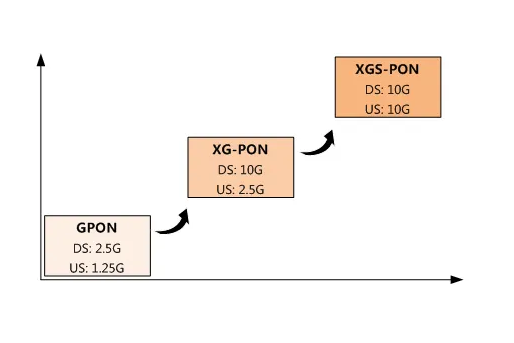Why XGS-PON is Essential for FTTx Deployments?
2024-08-24
As global internet usage continues to grow, the demand for higher bandwidth and faster speeds has become increasingly critical. To meet these demands, telecommunications companies are turning to advanced technologies like XGS-PON (10 Gigabit Symmetrical Passive Optical Network) for Fiber-to-the-x (FTTx) deployments. XGS PON represents a significant evolution from its predecessor, GPON (Gigabit Passive Optical Network), and offers a range of benefits that make it ideal for modern FTTx networks.

1. Higher Bandwidth Capacity
One of the most significant advantages of XGS-PON is its ability to deliver higher bandwidth. Unlike GPON, which provides 2.5 Gbps downstream and 1.25 Gbps upstream, XGS-PON offers symmetrical 10 Gbps speeds for both upstream and downstream. This capacity is crucial for handling the ever-growing data demands driven by applications such as 4K/8K video streaming, online gaming, and cloud computing. By providing 10 Gbps of symmetrical bandwidth, 10G PON ensures that end-users experience seamless, high-speed internet connections, even during peak usage times.
2. Future-Proofing the Network
XGS-PON's higher capacity makes it an excellent choice for future-proofing FTTx deployments. As the digital landscape evolves, the demand for bandwidth-intensive applications will only increase. XGS-PON networks can accommodate these demands without requiring significant infrastructure upgrades. This capability ensures that service providers can continue to deliver competitive offerings in the market, protecting their investments over the long term.
3. Symmetrical Speeds for Enhanced User Experience
Symmetry in internet speeds has become increasingly important as users rely more on cloud services, video conferencing, and online collaboration tools. XGS-PON’s symmetrical 10 Gbps speeds allow for faster uploading and downloading, improving the user experience. For businesses, this means more efficient data handling, quicker backups, and smoother video conferencing. For consumers, it results in faster uploads of high-definition content and an overall more responsive internet experience.
4. Improved Network Efficiency
XGS-PON enhances network efficiency by supporting more users per Optical Line Terminal (OLT) compared to GPON. This efficiency reduces the cost per subscriber for service providers, enabling them to offer competitive pricing. Additionally, the symmetrical nature of XGS-PON reduces congestion during peak times, ensuring consistent service quality.
5. Support for Advanced Services
With its higher bandwidth and symmetrical speeds, XGS-PON is well-suited for supporting advanced services such as 5G backhaul, enterprise services, and smart city applications. The increased capacity allows service providers to deliver a wide range of high-performance services over a single network, improving operational efficiency and opening up new revenue streams.
6. Seamless Upgrade Path
For service providers currently using GPON, upgrading to XGS-PON is relatively straightforward. XGS-PON can coexist with GPON on the same infrastructure, allowing for a gradual upgrade process. This coexistence means that service providers can introduce XGS-PON services without disrupting existing GPON services, minimizing downtime and ensuring a smooth transition for end-users.
7. Cost-Effectiveness
While XGS-PON represents a significant technological advancement, it also offers cost-effective deployment options. The ability to run XGS-PON alongside existing GPON infrastructure reduces the need for costly overhauls. Moreover, as XGS-PON technology becomes more widely adopted, the cost of related hardware and components is expected to decrease, making it an increasingly attractive option for service providers.
8. Enhanced Security Features
In today’s digital age, security is a paramount concern. XGS-PON networks offer enhanced security features that protect against potential threats. The encryption capabilities of XGS-PON ensure that data transmitted over the network is secure, providing peace of mind for both service providers and end-users. Additionally, the ability to isolate specific channels within the network helps in maintaining the integrity of sensitive data transmissions.
9. Scalability and Flexibility
XGS-PON is highly scalable, making it ideal for networks of all sizes, from small local deployments to large-scale metropolitan areas. Its flexibility allows service providers to adapt the network as needed, adding new users and services without significant infrastructure changes. This scalability and flexibility ensure that 10G PON can meet both current and future demands.
10. Environmental Benefits
Finally, XGS-PON contributes to environmental sustainability. The technology enables more efficient use of network resources, reducing the need for extensive physical infrastructure. Additionally, by supporting higher data rates over longer distances, XGS-PON minimizes the need for additional power-hungry equipment, thereby lowering the overall energy consumption of the network.
The many benefits of XGS-PON make it the first choice for service providers to meet the needs of modern Internet usage. Higher bandwidth, symmetrical speeds, scalability, and cost-effectiveness make XGS-PON a future-proof solution that will continue to support the development of digital services. As the digital world continues to expand, the adoption of 10G PON will be key to delivering the high-performance Internet services that consumers and businesses expect.








